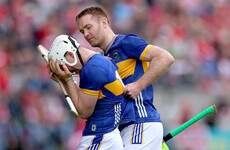IN PART ONE of this analysis of Munster’s defeat to Toulon, we looked at some of the more positive aspects of the Irish province’s performance, particularly in contact and on their own restarts.
Those elements simply weren’t enough to drive Rob Penney’s men to success though, as their errors added up over the course of the 80+ minutes. Toulon clearly deserve plenty of credit for their efforts in achieving victory, but Munster’s focus in moving on from this game will be most likely be internal.
Penalties count against Wilkinson
The 12 penalties Munster conceded was a joint seasonal high for them in the Heineken Cup. There were 12 given up away to Perpignan in the pool stages too, when Tommaso Allan missed three of his penalty kicks at goal.
That was never going to be the case with Jonny Wilkinson over the tee for Toulon, and the former England out-half duly showed his class as he was off target with just one of his seven kicks at goal, also adding in a drop goal.
The frustration for Munster is that many of their penalty concessions were preventable, such as the one that allowed Wilkinson to open the scoring in this semi-final.
CJ Stander was generally superb in these types of situation throughout the game – as we highlighted yesterday – but on this occasion, he gets it narrowly wrong. There is no clear disconnect between his tackle on Bastareaud and the attempt to steal the ball.
This penalty comes after Toulon ran one of the wide screen plays that proved effective against Munster and Stander is scrambling to cover back. In those ‘emergency’ scenarios, discipline so often goes out the window, so credit goes to Toulon for stressing Munster here.
The penalty above was perhaps more frustrating for Munster, coming as it did after some excellent initial work from Sean Dougall. The Munster openside makes a dominant hit on Drew Mitchell after the Australian wing collects Mathieu Bastareaud’s loose pass, then fights to stay on his feet and win the space over the ball.
In the clip above, we can see Dougall using his hands to bear crawl just beyond the ball – against the letter of the law, but excellent technique in a situation like this one. As Toulon finally get to grips with the Munster flanker, clearing him away, the ball is dragged out the left side of the ruck.
Unfortunately, Simon Zebo makes an instinctive reaction and gives the ball a gentle nudge from an offside position. It’s extremely difficult to avoid doing so, but it’s likely that Felix Jones would have been able to collect the ball from on onside position even without that touch.
Before we go any further, it’s worth stressing that the intention here is not to pick on individual players. In a highly stressful Heineken Cup semi-final, mistakes are a normal part of the game. The intention is instead simply to pinpoint some of the reasons Munster ended up with a loss in Marseille.
The penalty that allowed Toulon to go 15-9 ahead, shown above, was for offside again, and also involved an instinctive reaction. This was a lack of luck in many regards, but Munster will look at how they can avoid similar circumstances in the future rather than blame misfortune.
Stander loses the ball in contact against the lighter Matt Giteau [who hits far above his weight, to be fair] and will likely be self-critical of his carrying technique. Obviously, Munster wanted to win the collision on every single carry they made, but there are areas of the pitch where more ball security is needed.
As we see above, Stander goes into contact with the ball in front, and in an upright position. He is striving to gain as many metres as possible in order to help create a more favourable exiting position for Munster, but the lack of ball security proves costly.
For an example of Munster making this type of carry more effectively, we look to Damien Varley in the video below.
The Munster hooker is a less explosive carrier than Stander, and generally has different habits than the South African in entering contact, but there is far more security in his carry here.
The ball is further away from the contact, tucked in one arm but pulled away from the tackling Juan Martín Fernández Lobbe, and Varley is focused on getting to deck early, thereby allowing the ball to be freely presented for Conor Murray at scrum-half.
Different carries can sometimes suit different positions on the pitch.
Unfortunately, Munster’s indiscipline lasted into the final minutes of the game, as substitute Donnacha O’Callaghan was pinged for not rolling away before Wilkinson kicked the penalty to make it 24-16.
We highlighted the excellence of Munster’s choke tackle efforts in part one of this analysis, but the example above demonstrates an occasion on which Penney’s men got it wrong.
Callaghan and Keith Earls get into good positions around the ball, but the carrying Alexandre Menini wins the ‘fight’ to take the contact to deck before Barnes indicates that a maul has formed.
That leaves O’Callaghan clamped onto the ball and tied into that position by the rucking Martin Castrogiovanni, making it hugely difficult to roll away. Again, the point here is that a slight lack of technical execution in Munster’s actions results in concession of a penalty.
There were some contentious calls among the decisions that went against Munster, but it would be frankly ridiculous to blame Munster’s defeat on the referee. One of the more interesting calls was that given in the clip below.
Steffon Armitage breaks away alone from the initial maul, before being wrapped up by Stander and Varley in those classic choke tackle positions. As Dave Foley and Bryan Habana engage, Barnes calls ‘maul!’ and it appears that a turnover is coming Munster’s way.
However, the match official penalises Munster for dragging the maul down, something we haven’t seen too many times before. Wilkinson actually misses the relatively straightforward penalty, so perhaps justice is done, but it was an interesting call.
Handling errors add up
Every team in the world is guilty of knock-ons but against Toulon, Munster’s mistakes in this area added up to denying them several promising attacking possibilities. Again, we underline that there is no sense of putting the spotlight on individuals making errors.
Perhaps the most memorable knock-on by Munster came after the [in]famous decision to kick to touch with their 71st-minute penalty.
The error comes on fourth phase for Munster, and it’s an unusual position for Laulala to find himself carrying in. There was a sense that Penney’s men were slightly rushed in this passage of play, having initially been repelled at the maul.
Munster quite probably hung their hopes on driving forward through the maul [as we will will touch on again later], and there was a slight lack of organisation by the time Laulala offered himself up to carry.
Not to suggest that the Kiwi centre didn’t want to take the ball in this position, but it is not one he is most suited to. A little more clarity of thought might have seen Munster wait for another pod of forwards to arrive around the corner to carry.
These visits into the opposition 22 are crucial in any game and on his occasion, Munster came away empty handed, which proved decisive in the final scoreline.
Munster did enjoy more than 50% of the possession in this game, and their failure to break down the Toulon defence [aside from the Simon Zebo try] was as much down to the French team’s organisation as anything.
However, further handling errors ruined several of the more promising attacking situations for Munster, as in the example above where Murray just knocks-on at the base of the ruck after his side get promising possession.
It’s far from a clear-cut try-scoring chance, but it is a favourable situation for Munster, especially with Laulala and Zebo in space wide on the left.
There was no guarantee of a linebreak in this instance, but there was certainly the possibility of gainline advances and creation of an even more promising position. Toulon are in that ‘scrambling’ mentality in defence and perhaps would have been forced into conceding a penalty within kicking range for Keatley.
This error came with the score at 18-16 in Toulon’s favour, but the momentum firmly having shifted towards Munster.
Below, we get a similar example just minutes later in the game, following directly from the superb James Coughlan turnover we studied in part one of this piece. This time Keatley is the man to lose the ball in a favourable attacking position.
This kind of turnover possession is lifeblood for the counter-attacking team, providing an excellent chance to burst back at a slightly disorganised defence in broken-up play, but the Munster knock-on wastes a good opportunity to do so.
Again, Zebo and Laulala are the men wide on the left, hungering for the ball to find them in space. It’s worth nothing that Mitchell is out of shot in the situation below, but it remains an opportunity for Munster to deeply stress the Toulon defence.
There was a general lack of inaccuracy in Munster’s handling at key times, something that may have disappointed the management team, having dedicated much time to improving these skills over the past two seasons.
The error from Paul O’Connell below came on 37 minutes, with Munster trailing 15-9 and aiming to build a score before the interval. Instead, Habana seizes possession and swings the momentum back in Toulon’s favour again.
The mistake on the restart reception from Coughlan below ended with Wilkinson stepping into the pocket and striking a remarkably composed drop kick. Munster will view those as three cheap points to have conceded directly from a handling error.
The final handling mistake from Munster leads to the closing score of the clash, as Keith Earls spills an inside pass from Keatley. At 21-16, Munster still have some hope of finding a winning try, but this error turns possession back to Toulon, who win a penalty as O’Callaghan fails to roll away just phases later.
Against a poorer opposition, this accumulation of handling errors may not have proved as costly, but against this Toulon side, every mistake is punished. For all the superb work Munster did in contact and through their restarts, the build-up of preventable errors made it very difficult for them to win this semi-final.
Toulon face up to the maul
Munster’s maul was deservedly lauded as a weapon in the build up to this game, but it ended up having very little effect on the outcome. Zebo’s try originated from an attacking maul inside the Toulon 22, but in truth it was not an overly dominant one [although it could be argued that it drew Toulon's focus, thereby opening the space for Munster to score down the blindside.
The handling inaccuracy extended to the Munster maul at one stage, as they knocked the ball on in their efforts to set up a drive inside the Toulon half during the opening period.
Munster have transferred the ball from line-out jumper to the binding player at the maul superbly well all season, but this time it lets them down as Dave Foley loses the pill in his efforts to swim to the back of the forming maul.
There weren’t a huge amount of mauls from Munster in this game, but they were biding their time, waiting for the one clear opportunity to shunt Toulon back over their line. That came in the 72nd minute, after the decision was made to go to touch after winning a penalty.
Munster would have been focused on using one of their major strengths to score in this instance, but Toulon were well prepared for what was to come.
Munster make a clean catch in the air, and it’s notable that Toulon do not compete, instead choosing to keep every one of their players on the deck. Furthermore, the French side don’t even think about going for the sack, again ensuring that all their power can be dedicated to shunting Munster backwards.
The drive from Toulon is perfectly timed, utilising their exceptional power to ensure that Munster don’t have that split second they need to set themselves to drive forward. Toulon’s low, straight-backed drive sends Munster back three metres, before Stander shears away from the maul to the right.
Munster will have been disappointed that one of their main strengths didn’t deliver under intense pressure, but Toulon’s defensive effort was remarkable.
Lessons learned for next season
In a high-stakes game such as this one, Munster’s penalty count and handling errors ultimately added up to deny them a sustained shot at success. Toulon clearly made mistakes of their own, but those were less frequent than their opponents’.
The match was still there for Munster in that second-half surge of momentum after Zebo’s try, but the final ‘big play’ that they needed failed to materialise, and instead those same errors returned to cut off the hope.
After two consecutive semi-final defeats in the Heineken Cup, incoming head coach Anthony Foley may feel he has learned enough to push the province into taking that final step next season.






















Enough about the Munster match… Jeysus!
Build a bridge and all that. Fook sake
Great solution lads, don’t go into the article if it’s so pointless
Nice analysis Murray. I’d like to know your opinion on the off sides at rucks in this seasons matches in general..players unbound to the ruck and not retreating behind the hindmost foot is being ignored by the ‘assistant referee’s’ and getting to be as infuriating as the crooked put in to scrums which is not being enforced as it was earlier in the season. The off sides in the Toulon game was evident and the red shirts in particular did not retreat and were up very quickly in defense. The officiating is terrible where the obvious infringement is evident …what are the assistant referee’s looking at?
Hi Des, I have to say it’s not a trend I’ve noticed myself. There are of course incidents of offside in most matches that go unpunished, as it’s hard for the match officials to see everything live when they are at ground level. Lots of defences are operating with a huge amount of line speed now, living constantly on the edge of being offside. I’ll definitely keep a closer eye out for it in the future though, thanks very much for highlighting it.
Get over!! Move on!! Ye were well beat and all the moaning and wallowing in self pity won’t change that.
Thanks for the reply Murray. I’d have to disagree with it though. At ground level the ‘assistant referee’s’ are supposed to keep up with the play and should be in line at ruck time in a good position to see any off side ‘transgressions’. This is professional rugby and the officials have to be fit enough to keep up. I don’t think the increased line speed, going forward, has anything to do with retreating behind the hindmost foot, going backwards, but it has everything to do with being offside.
The second question… the crooked feed in to the scrum was being enforced at the beginning of the season and in the new year not ? I understand that we’ll rarely if ever get a perfectly officiated game but this is a basic law of the game ensuring fair contest as is the line out throw of which on Sunday there were several crooked throws and I recall one being penalised.
The inconsistency of the officiating on the very basic laws of the game is rampant at the top levels.